Isabella Bradford's Blog, page 63
February 14, 2016
Germs Discovered in 1835
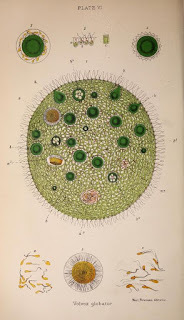 Volvox globator
Loretta reports:
Volvox globator
Loretta reports:Well, I’ve just gone down a rabbit hole, all on account of this entry in the Athenaeum of 26 September 1835 (first column).
‘An Essay on the Nature of Diseases, by A. Green, L.L.B.‘—An essay on mirth by an undertaker, we could understand, for things may be defined by their contraries; but an essay on diseases by an L.L.B., was rather puzzling, until the secret transpired in the few first pages. The author has been to see the oxy-hydrogen microscope exhibited, and has been “ frighted from his propriety" by the spectacle. His hallucination is, that all diseases are occasioned by animalculae; and his logical formula is this: “ whatever may be, may be; nothing prevents it from being, therefore it is." It is curious to remark. that this theory ends precisely where all other medical theories have hitherto ended. " We may know, or at least believe, that a disease is caused by some minute creatures, of some kind, situated somewhere; but we may neither know the kind, nor the situation, nor what medicines can be made to come into contact with them, nor what will destroy them when it is in contact, except by experience. The means of cure can only be known by experience; and experience must therefore still be the foundation of medical science, or at least of such part o fit as is of practical utility." This, which is the last sentence of the book, looks something like a return to reason; and we hope that this first victory of the sane over the lunatic animalculae may be followed up to a complete and final conquest. In this hope, we should have passed the matter in silence, but that it affords a not uncommon specimen of "graduated" wisdom, which it may be useful to study, at the present moment of university reformation ; and as such, we recommend it to public attention.
Here's an excerpt from Mr. Green's Essay on the Nature of Diseases (1835):
It is known to every one, that by the aid of the microscope, there may be seen in water which has been exposed for some time to the open air, minute animated beings, generally very transparent, and presenting an organization more or less simple ... The popular interest recently acquired by the solar microscope, and still more by the oxy-hydrogen microscope, induces us to believe that all our readers have sufficient knowledge of the microscopic animalcula, to be interested in the discoveries which have recently been made in the part of natural history, which relates to them.
Nearly all the reviewers went ballistic:
“The proposition that animalcules are the causes of all diseases is not new, neither is it true. Thus to imagine that animalcules are the cause of all continued and intermittent fevers, all contagious diseases, syphilis, plague, hydrophobia, small-pox, measles, hooping-cough, scarlatina, sea-scurvy ... appears to us not only untenable, but perfect nonsense.”—London Medical and Surgical Journal 1835.
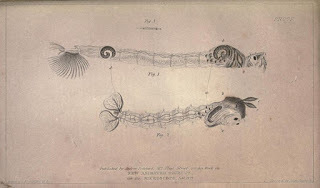 Microscopic creature 1829 image
Microscopic creature 1829 image
Review in The Spectator, Volume 8, 1835. Somewhat more open-minded review in The Metropolitan Magazine , Volume 13, 1835 (Bottom of page).
Images: (above) Volvox globator , from The Microscope and Its Revelations, 1891; (below) Microscopic illustrations of living objects, 1840—note that the image was drawn in 1829.
Clicking on the image will enlarge it. Clicking on the caption will take you to the source, where you can learn more and enlarge images as needed.
Published on February 14, 2016 21:30
February 13, 2016
Breakfast Links: Week of February 8, 2016
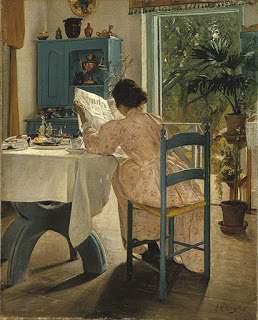 Breakfast Links are served - our weekly round-up of fav links to other web sites, articles, blogs, and images via Twitter.
Breakfast Links are served - our weekly round-up of fav links to other web sites, articles, blogs, and images via Twitter.• Revealing the truth about 18thc women's necklines .
• Strawberry Hill : Horace Walpole's eccentric house that inspired the Gothic Revival.
• How daylight shaped the worklives of 16th-17thc people.
• Twenty-four Old English words we should start using again.
• Tracking down an early 19th London tailor's family and his shop.
• Image: "Better than a dog" but "less money for books": Charles Darwin's 1838 list of reasons for and against marrying.
• Breakfast with John Adams.
• Medieval challenges: how do you put a torc around your neck?
• How LACMA added this rare surviving zoot suit to its collections.
• Image: This headstone is the definition of a "badass."
• The first known fencing master in America was a Black man who escaped slavery.
• In search of Queen Victoria's voice .
• Restoration of Roman tunnels gives a slave's eye view of Caracalla Baths .
• The full story of the body (and severed head) of Charles I .
• "Dear Rosey": an 18thc British soldier far from home seeks help from his wife.
• Image: There is so much to love about this 19th headline .
• Ever-evolving toyland: Barbie's lurid past in the 1940s as a sexy German call girl.
• When pyjamas ruled the fashion world.
• Image: Yanks in Germany want more books .
• How an 1830s children's magazine taught the hard truths of slavery.
• The funeral of Queen Jane Seymour .
• New exhibition highlights "plus-size" garments across four centuries.
• A cheerier version of the Depression years, in hyper-bright postcards of recreatio spots.
• Image: Ornate Victorian public toilet .
Hungry for more? Follow us on Twitter @2nerdyhistgirls for fresh updates daily.
Above: At Breakfast by Laurits Andersen Ring. Private collection.
Published on February 13, 2016 14:00
February 11, 2016
Friday Video: A Day in Pompeii
 Loretta reports:
Loretta reports:My nerdy history interest in England has continued for many years alongside an abiding fascination with Ancient Egypt, Greece, and Rome. One of my latest purchases is Mary Beard’s SPQR . In the world of fictional detectives, I’ve been a devoted follower of Lindsey Davis’s Falco series.
So of course Pompeii fascinates me. There are much longer programs on the subject, including this one hosted by Mary Beard.
But I found this short video animation rather haunting.
You can read more of Mary Beard on the subject of Pompeii here.
Readers who receive our blog via email might see a rectangle, square, or nothing where the video ought to be. To watch the video, please click on the title to this post.
Published on February 11, 2016 21:30
February 10, 2016
From the Archives: The Myth of the Regency Sylph
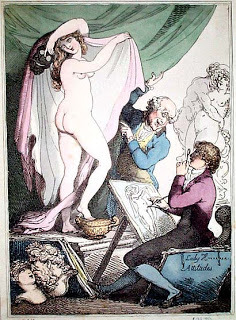 Isabella reporting:
Isabella reporting:Seeing the fashions of 1810 featured in Loretta's blog reminded me of how fashion influences more than just silk and ribbons: it can also determine the stylish ideal of the body beneath those clothes.
Too often, however, the modern perception of what was hot in the late 18th-early 19th c is more a reflection of 21st ideals, especially as influenced by contemporary film versions of Jane Austen's novels. Our sylphs would not have been theirs. Keira Knightley, right, and Gwyneth Paltrow would have been pitied as sad, scrawny creatures, even perhaps consumptive. The ladies that everyone was ogling in a real Regency ballroom would have looked much more like this caricature of the notorious Emma, Lady Hamilton , left, by Thomas Rowlandson .
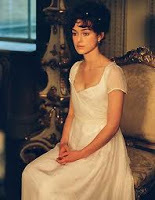 While later in her career, Emma would be cruelly depicted as
blowsy and obese
, here she is shown as an eminently desirable and fashionable beauty, with high breasts and well-rounded thighs and bottom. The same kind of lush figure tumbles through countless other drawings by Rowlandson and
James Gillray
; Google either artist, and you'll see these women over and over. It's easy to look at this body-type and imagine it wearing the clothes in the 1810 fashion plate, or in
this
one from 1808
While later in her career, Emma would be cruelly depicted as
blowsy and obese
, here she is shown as an eminently desirable and fashionable beauty, with high breasts and well-rounded thighs and bottom. The same kind of lush figure tumbles through countless other drawings by Rowlandson and
James Gillray
; Google either artist, and you'll see these women over and over. It's easy to look at this body-type and imagine it wearing the clothes in the 1810 fashion plate, or in
this
one from 1808The more flattering portrait of Emma, below, also shows exactly how robust a stylish lower half must have been. With fashion dictating a temporary respite from boned corseting, narrow waists lost their importance as an erogenous zone. Instead the interest shifted to the lush, voluptuous curves below the waist, revealed by the drifting drapery of light silks and linens. For men who had been raised in an era when these mysterious body-parts had been hidden by hoops and heavily draped skirts, the sudden change must have been...exciting.
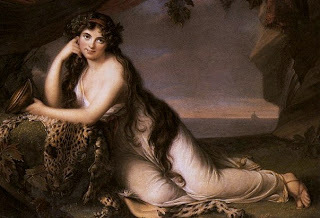 Where did this different kind of body ideal come from? Just as ancient Roman and Greek art and architecture was influencing nearly every aspect of the decorative arts in the late 18th-early 19th c, fashion, too, took a classical turn. High-waisted gowns and draping shawls were designed to emulate ancient fashions, embroidery patterns featured classical motifs, and looped and knotted hairstyles showed a classical influence as well.
Where did this different kind of body ideal come from? Just as ancient Roman and Greek art and architecture was influencing nearly every aspect of the decorative arts in the late 18th-early 19th c, fashion, too, took a classical turn. High-waisted gowns and draping shawls were designed to emulate ancient fashions, embroidery patterns featured classical motifs, and looped and knotted hairstyles showed a classical influence as well.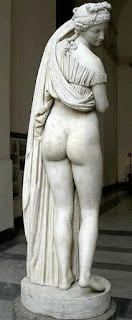 But the undressed bodies of ancient nude statuary also set new standards of physical beauty. While Georgian aristocrats on their Grand Tours were busily checking out naked marble goddesses all across the Continent, one of the must-see statutes was the
Aphrodite Kallipygos,
right, on display in Naples. This much-admired statue is thought to be a 1st c BC Roman copy of an earlier Greek bronze, and her provocative pose must have left a definite impression of classical booty on countless young Englishmen.
But the undressed bodies of ancient nude statuary also set new standards of physical beauty. While Georgian aristocrats on their Grand Tours were busily checking out naked marble goddesses all across the Continent, one of the must-see statutes was the
Aphrodite Kallipygos,
right, on display in Naples. This much-admired statue is thought to be a 1st c BC Roman copy of an earlier Greek bronze, and her provocative pose must have left a definite impression of classical booty on countless young Englishmen.The statue may also have influenced Lady Hamilton, living with her husband Sir William in Naples. For special guests to their villa, Emma performed her "Attitudes," a series of graceful poses inspired by classical art – the same "Attitudes" satirized by Rowlandson in the caricature at the top of this page. While Emma performed in a quasi-classical costume, not in the buff as Rowlandson shows her, there is a similarity between the pose – and the voluptuous figure.
Top left: Lady Hamilton's Attitudes by Thomas Rowlandson, 1790
Lower left: Detail, Emma, Lady Hamilton as Ariadne by Elisabeth Vigee-Lebrun, 1790
Lower right: Aphrodite Kallipygos, artist unknown, 1st c BC, National Archaeological Museum, Naples
Published on February 10, 2016 21:00
February 8, 2016
Queen Victoria's Stormy Wedding Day
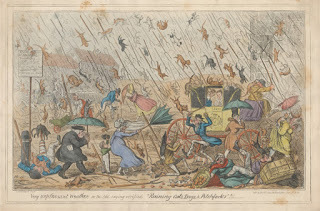 Cruikshank, Very Unpleasant Weather
Loretta reports:
Cruikshank, Very Unpleasant Weather
Loretta reports:This week in history—
Queen Victoria married Prince Albert of Saxe-Coburg and Gotha on 10 February 1840. I used the event, and the bad weather preceding it, as a backdrop to a short story.
“The weather during the preceding night was more boisterous than any we have experienced during the winter. It “blew great guns from ten o’clock until sunrise when—The detailed account of the wedding begins here . And you can find my other blogs on the subject here and here . If you search “white wedding dress,” you’ll find posts explaining that Queen Victoria was not the first bride to wear white.
The dawn was overcast, the morning lower’d,
And heavily in clouds brought on the day,
The great, th’important day,
on which were to be celebrated the nuptials of our maiden Sovereign and Prince Albert of Saxe Coburg.
It continued to rain almost without intermission until noon, when the weather partially cleared up and continued fine, but threatening during the remainder of the day.”— The Mirror of Literature, Amusement, and Instruction, 1840
Image: George Cruikshank, Very Unpleasant Weather ,1835, courtesy Yale Center for British Art, Paul Mellon Collection.
Clicking on the image will enlarge it. Clicking on the caption will take you to the source, where you can learn more and enlarge images as needed.
Published on February 08, 2016 21:30
February 7, 2016
Advice for Writers of Romantic Fiction, 1790 - and 2016
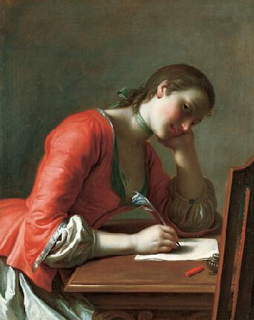 Isabella reporting,
Isabella reporting,Publishers, editors, and critics have always been ready with suggestions for writers - handy rules that, if followed, are sure to guarantee a story that readers will devour. The advice in the clipping, below right, comes from an 18thc newspaper, The World, appearing in the September 17, 1790 edition. Although nearly 250 years old, modern writers and readers of romantic fiction may find these rules surprisingly (or perhaps depressingly) current.
I've transcribed them below:
"It is absolutely necessary for female NAMES to be culled with delicacy, that they may be more interesting – HARRIET, ISABELLA, LEONORA, AUGUSTA, INDAMORA, FLORINDA, WILHEMINA, ALMERIA, SOPHONISBA, &C. And as for surnames, take the NEVILLES, the GRENVILLES, the BELVILLES, the SAVILLES, the HOWARDS, the GODOLPHINS, the MOWBRAYS, and the MONTGOMERIES; be particularly careful, that they are all Honourable, or Right Honourable, or Dutchesses, or Countesses, or Baronesses, or Baronetesses, by which means the dignity of the story is preserved; for who could with any decency be supposed to love HANNAH GRIMES, or MARTHA DICKENS, or MARGARET SIMS! As for the MEN, they must all be Lords, Knights, Captains, Colonels, or Counts, and should generally keep phaetons and four, or elegant little gigs; they must have fought duels without end, and be fond of deep play; and if, from excess of sensibility, they have occasioned a FEW DIVORCES, it makes the work infinitely more interesting.
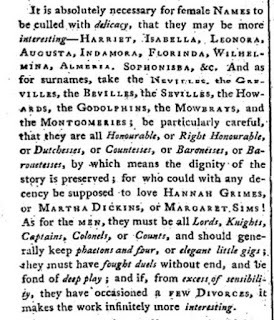
The more things change....
Many thanks to another of our friends of the blog, writer/historian Emily Brand, who spotted this item for us.
Above: Young Girl Writing a Love Letter, by Pietro Antonio Rotari, c1755, Norton Simon Art Foundation.
Published on February 07, 2016 17:00
February 6, 2016
Breakfast Links: Week of February 1, 2016
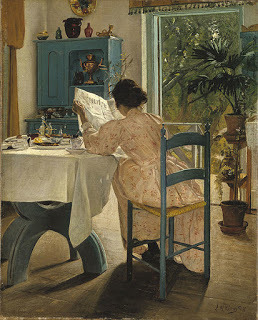 Breakfast Links are served - our weekly round-up of fav links to other web sites, articles, blogs, and images via Twitter.
Breakfast Links are served - our weekly round-up of fav links to other web sites, articles, blogs, and images via Twitter.• The history of resourceful 20thc clothing made from printed flour and feed sacks .
• Fascinating new site from the Newberry Library highlighting historical paleography (history of handwriting.)
• "Like swallowes", or what happens when a 17thc poem meets a recipe for face cream.
• An 1851 chemise for comfort.
• Drunkard, Merryboy, Younker: some popular names for 17thc • Image: Women from India, Syria, and Japan who completed their medical education in Philadelphia, 1885.
• Ten fabulous French chateaux for sale in case you win the lottery.
• Do you have an "open head"? Mrs. Corlyn's unique headache remedies can address that.
• Image: Animation showing how Boston's Old State House - and its setting - has changed over the centuries.
• Elite dining in early 1900s Manhattan: frogs legs and potato chips.
• Eight classic novels reduced to their punctuation.
• Ancient Romans once filled the Colosseum with water and staged a mock sea battle.
• Victorian cat funerals.
• Image: The blue-and-white dishes in this 17thc Dutch doll house are Chinese export ware.
• Transportation and love tokens.
• Napoleon was a popular subject for 19thc chess sets.
• Eight words that reveal the sexism at the heart of the English language.
• Historical sheet music: dancing Downton-style.
• London's Duke of Monmouth • "Laura had a feeling": Fascinating interpretation of Little House on the Prairie.
• Image: A tartan treat for celebrating Burns Night - Royal Stuart tartan kilt ensemble, 1822.
• The queen mother's rebel cousin.
• London's Sailortown: servicing the Royal Navy in the 18th-19th centuries.
• Rare painted cloth banner celebrating Thomas Jefferson's election over John Adams, 1800.
Hungry for more? Follow us on Twitter @2nerdyhistgirls for fresh updates daily.
Above: At Breakfast by Laurits Andersen Ring. Private collection.
Published on February 06, 2016 14:00
February 4, 2016
Friday Video: Boston by Streetcar, c1903
Isabella reporting,
Some of our most popular Friday Videos have featured turn-of-the-20th-century cities captured by early outdoor cameramen, usually from a streetcar. Here is Paris , and here's New York (in a blizzard) - and now we have these street scenes of Boston, c1903.
For those familiar with the city, this short film includes views of North Station, South Station, Atlantic Avenue, Copley Square, and Huntingdon Avenue. It's also a chronicle of urban transportation: while most people are traveling by foot, there are plenty of horse-drawn vehicles as well as streetcars, plus the newer trolleys and elevated cars whose tunnels are seen under construction. It's also a time without crosswalks or traffic lights, with pedestrians jaywalking with bravado. I love seeing how formally everyone is dressed, too, with almost every man and woman wearing a hat. For more about the film, see this article by the New England Historical Society .
This video was shared with me almost simultaneously by two of the blog's New England friends, Kimberly Alexander and Andrea Cawelti. Thank you both!
If you receive our blog posts by email, you may see a black box or an empty space where the video should be. Click here to view the video.
Published on February 04, 2016 21:00
February 3, 2016
The Hairdresser, 1827
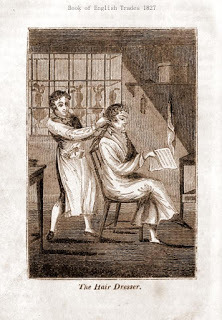 Hairdresser
Loretta reports:
Hairdresser
Loretta reports:The Book of English Trades was a guide aimed mainly at a young audience, explaining what people did and what they were paid. It continued to appear, year after year, and you can find it online in many editions. The clippings here are from the 1827 edition.
You can read the full entry online beginning here .
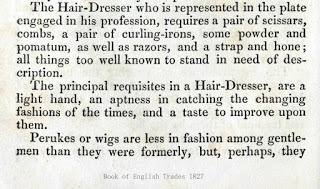
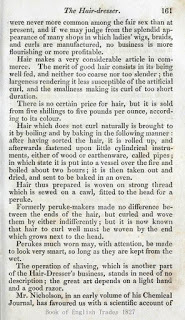
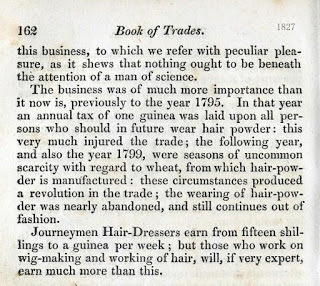
Clicking on the image will enlarge it. Clicking on the caption will take you to the source, where you can learn more and enlarge images as needed.
Published on February 03, 2016 21:30
February 1, 2016
Men in Kilts in Paris, 1815
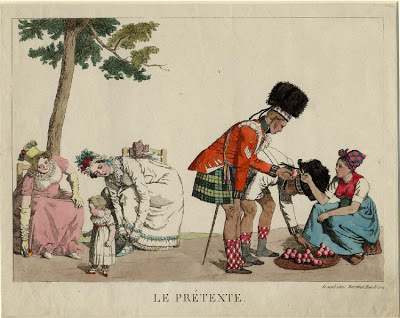
Isabella reporting,
Some things never change. While there can be no doubt as to the courage shown by Highlanders in battle over the centuries, the fascination with what they're wearing (or not) beneath their kilts appears to be at least two hundred years old, if this this print is any indication. (As always, please click on the image to enlarge.)
In October, 1815, when this print was made, the Treaty of Paris that ended the Napoleonic Wars had yet to be signed, but Paris and much of France was already occupied by soldiers from the Coalition countries that had defeated Napoleon. Among these countries was Great Britain, who contributed soldiers from Ireland, Wales, and Scotland as well as England.
Apparently the Highlanders shown here were among those soldiers occupying Paris. Strolling together through a park, they've paused to buy fruit from a vendor. As they bend down to complete their purchase, the two fashionably dressed women behind them are making not-so-subtle excuses to bend over themselves - one to retrieve the child's toy, the other to adjust the laces on her shoe - and thereby gain a, ahem, better view. The print's title, Le Prétexte, (The Pretense) says it all, doesn't it?
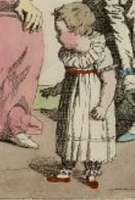
A small observation: while it's difficult to identify the gender of children in this era since both small boys and girls were dressed in much the same garments, I'm guessing that the toddler in the print, right, is male since he's playing with a ball, and not a doll, and the ribbon sash is red, a masculine color for the time. If you look closely, you'll see that beneath the child's gown he is is wearing gathered pantalettes, intended to keep him decent while he plays. The pantalettes appear to be plaid, much like the tartan of the soldiers' kilts. Hmm....
Above: Le Prétexte published by Aaron Martinet, Paris, October, 1815. The British Museum.
Published on February 01, 2016 21:00



